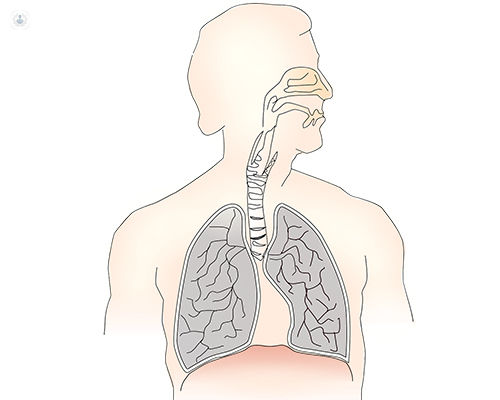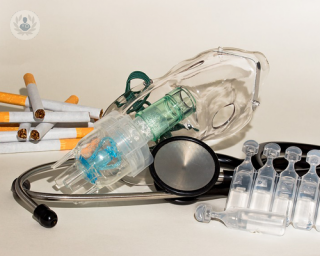Chronic obstructive pulmonary disease (COPD)
Dr Anne Mier - Pulmonology & respiratory medicine
Created on: 02-20-2013
Updated on: 10-12-2023
Edited by: Conor Lynch
What is chronic obstructive pulmonary disease?
Chronic obstructive pulmonary disease (COPD) is an umbrella term for a group of conditions that prevent the lungs from working properly and as a result, create breathing difficulties. The two most common forms of COPD are emphysema and chronic bronchitis. There is some debate on if asthma is considered a chronic obstructive pulmonary disease or if it is a separate respiratory condition.

What is the outlook for COPD?
Damage to the lungs from chronic obstructive pulmonary disease is permanent and the condition cannot be cured. However, treatment can help to keep the condition under control. In some people, breathing problems become progressively worse despite treatment and their quality of life is impaired.
What are the symptoms?
The main symptoms of chronic obstructive pulmonary disease are:
- Cough (with or without phlegm)
- Fatigue or tiredness
- Recurrent respiratory infections
- Shortness of breath (dyspnoea)
- Difficulty inhaling air
- Wheezing or whistling-sounds when breathing
How is COPD diagnosed?
If you have the symptoms related to chronic obstructive pulmonary disease and are referred to have further tests, you may have a spirometry test to evaluate how well your lungs work. You may also have blood tests or a chest x-ray performed to exclude the possibility of other conditions. If more tests are needed to confirm a diagnosis, you may undergo a CT (CAT) scan, a blood oxygen test, or perhaps an electrocardiogram (ECG) or echocardiogram to evaluate the heart.
What are the causes of COPD?
The leading cause of chronic obstructive pulmonary disease is related to exposure to irritants that injure the lungs and airways. The most common is tobacco smoke - both when inhaled as an active smoker and inhaled as passive smoker. Polluted air, chemical fumes, or dust from the environment are also irritants. In some cases, COPD is caused by a genetic tendency to develop the condition.
Can it be prevented?
The most effective way to try and prevent chronic obstructive pulmonary disease is to never smoke or to quit smoking if you have already started before lung disease can occur. If you already suffer from lung disease, you should stop smoking to prevent complications and slow the progression of the disease. You should also avoid exposure to the previously mentioned irritants in the environment.
How is COPD treated?
The basic goals of treating chronic obstructive pulmonary disease are:
- Relieving symptoms
- Delaying disease progression
- Improving the ability to stay active (by exercising)
- Preventing and treating possible complications of the disease
- Improving overall health
Bronchodilators
In addition, the doctor will recommend bronchodilators (a medication used to treat asthma and COPD which increases airflow) and potentially a combination of bronchodilators with inhalable glucocorticosteroids (steroids). There will also be cases in which pulmonary rehabilitation, oxygen therapy and lung volume reduction surgery are recommended. In the most severe cases, a lung transplant can be required.
What specialist treats COPD?
Specialists in pulmonology and respiratory medicine diagnose and treat chronic obstructive pulmonary disease.
Is COPD curable?
Unfortunately, there is currently no cure for COPD. The damage that the condition inflicts on one's lungs is irreversible.

What are the four stages of COPD?
The four main stages of chronic obstructive pulmonary disease are mild, moderate, severe, and very severe.
Can you get COPD even if you have never smoked?
Yes, it is possible for non-smokers and individuals who have never smoked to develop and get diagnosed with chronic obstructive pulmonary disease.
What are the main risk factors related to COPD?
There are a number of different risk factors of COPD that patient should be aware of. The main risk factors include:
- smoking cigarettes
- exposure to second-hand smoke
- long-term exposure to chemical fumes
- asthma
- chronic bronchitis
- age
- gender
- genetics
- recurrent respiratory infections
What is the difference between COPD and asthma?
Whereas COPD is usually diagnosed before the age of 40, asthma can be detected at a much younger age, typically being diagnosed, on average, before the age of 20. Moreover, in patients with chronic obstructive pulmonary disease, their symptoms tend to persist despite treatment, while asthma patients generally respond well to treatment, with symptoms coming and going. Chest X-rays in patients with COPD typically display changes in the individual's lungs, while chest X-rays are generally normal with no changes in patients with asthma.

















